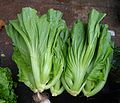
The turnip or white turnip is a root vegetable commonly grown in temperate climates worldwide for its white, fleshy taproot. Small, tender varieties are grown for human consumption, while larger varieties are grown as feed for livestock. "Turnip" is also used in Northern England, Scotland, Ireland, Cornwall, Devon, and parts of Canada, to regularly refer to rutabaga, also known as neep or swede, a larger, yellow root vegetable in the same genus (Brassica).

Cabbage, comprising several cultivars of Brassica oleracea, is a leafy green, red (purple), or white biennial plant grown as an annual vegetable crop for its dense-leaved heads. It is descended from the wild cabbage, and belongs to the "cole crops" or brassicas, meaning it is closely related to broccoli and cauliflower ; Brussels sprouts ; and Savoy cabbage.
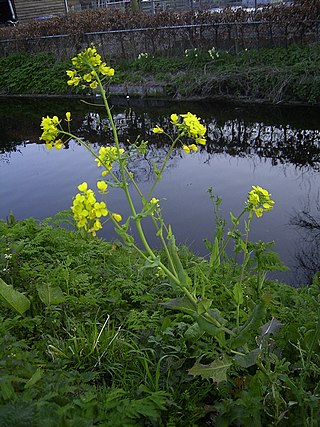
Brassica is a genus of plants in the cabbage and mustard family (Brassicaceae). The members of the genus are informally known as cruciferous vegetables, cabbages, or mustard plants. Crops from this genus are sometimes called cole crops—derived from the Latin caulis, denoting the stem or stalk of a plant.

Rapeseed, also known as oilseed rape, is a bright-yellow flowering member of the family Brassicaceae, cultivated mainly for its oil-rich seed, which naturally contains appreciable amounts of erucic acid. The term "canola" denotes a group of rapeseed cultivars that were bred to have very low levels of erucic acid and which are especially prized for use as human and animal food. Rapeseed is the third-largest source of vegetable oil and the second-largest source of protein meal in the world.
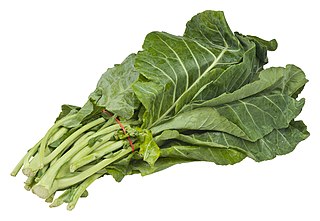
Collard is a group of certain loose-leafed cultivars of Brassica oleracea, the same species as many common vegetables including cabbage and broccoli. Collard is generally described as part of the Acephala (kale) cultivar group, but gets its own variety as Brassica oleracea var. viridis. The name "collard" comes from the word "colewort".

Kale, also called leaf cabbage, belongs to a group of cabbage cultivars grown for their edible leaves, although some are used as ornamentals. Kale plants have green or purple leaves, and the central leaves do not form a head. Kales are considered to be closer to wild cabbage than most of the many domesticated forms of Brassica oleracea. It is derived from wild mustard.

Chinese cabbage is either of two cultivar groups of leaf vegetables often used in Chinese cuisine: the Pekinensis Group and the Chinensis Group.

Rapini or broccoli rabe is a green cruciferous vegetable, with the leaves, buds, and stems all being edible; the buds somewhat resemble broccoli, but do not form a large head. Rapini is known for its bitter taste, and is particularly associated with Mediterranean cuisine.
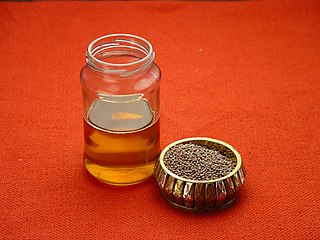
Mustard oil can mean either the pressed oil used for cooking, or a pungent essential oil also known as volatile oil of mustard. The essential oil results from grinding mustard seed, mixing the grounds with water, and isolating the resulting volatile oil by distillation. It can also be produced by dry distillation of the seed. Pressed mustard oil is used as cooking oil in some cultures, but sale is restricted in some countries due to high levels of erucic acid. Varieties of mustard seed also exist that are low in erucic acid.
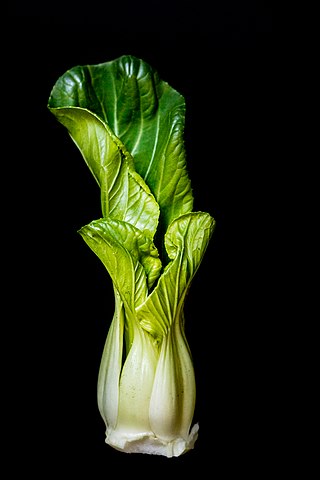
Bok choy, pak choi or pok choi is a type of Chinese cabbage, used as food. Chinensis varieties do not form heads and have green leaf blades with lighter bulbous bottoms instead, forming a cluster reminiscent of mustard greens. It has a flavor between spinach and water chestnuts but is slightly sweeter, with a mildly peppery undertone. The green leaves have a stronger flavor than the white bulb.

Leaf vegetables, also called leafy greens, pot herbs, vegetable greens, or simply greens, are plant leaves eaten as a vegetable, sometimes accompanied by tender petioles and shoots. Leaf vegetables eaten raw in a salad can be called salad greens.

Rhamphospermum nigrum, black mustard, is an annual plant cultivated for its dark-brown-to-black seeds, which are commonly used as a spice. It is native to cooler regions of North Africa, temperate regions of Europe, and parts of Asia.

Brassica rapa is a plant species growing in various widely cultivated forms including the turnip ; Komatsuna, napa cabbage, bomdong, bok choy, and rapini.

The mustard plant is any one of several plant species in the genera Brassica and Sinapis in the family Brassicaceae. Mustard seed is used as a spice. Grinding and mixing the seeds with water, vinegar, or other liquids creates the yellow condiment known as prepared mustard. The seeds can also be pressed to make mustard oil, and the edible leaves can be eaten as mustard greens. Many vegetables are cultivated varieties of mustard plants; domestication may have begun 6,000 years ago.
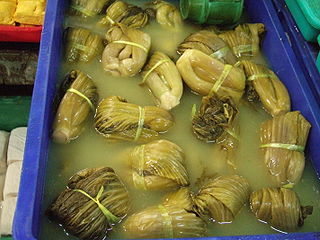
Suancai is a traditional Chinese pickled Chinese cabbage or Chinese mustard, used for a variety of purposes. Suancai is a unique form of paocai, due to the ingredients used and the method of production.

Tatsoi is an Asian variety of Brassica rapa grown for greens. Also called tat choy, it is closely related to the more familiar bok choy. This plant has become popular in North American cuisine as well, and is now grown throughout the world.

Crotalaria juncea, known as brown hemp, Indian hemp, Madras hemp, or sunn hemp,धाकटी घागरी, is a tropical Asian plant of the legume family (Fabaceae). It is generally considered to have originated in India.

Zha cai, also romanized as Cha tsai, is a type of pickled mustard plant stem originating from Chongqing, China. The name may also be written in English as cha tsai, tsa tsai, jar choy, jar choi, ja choi, ja choy, or cha tsoi. In English, it is commonly known as Sichuan vegetable, Szechwan vegetable, or Chinese pickled vegetable, although all of these terms may also refer to any of a number of other Chinese pickles, including the several other types in the Sichuan province itself.







